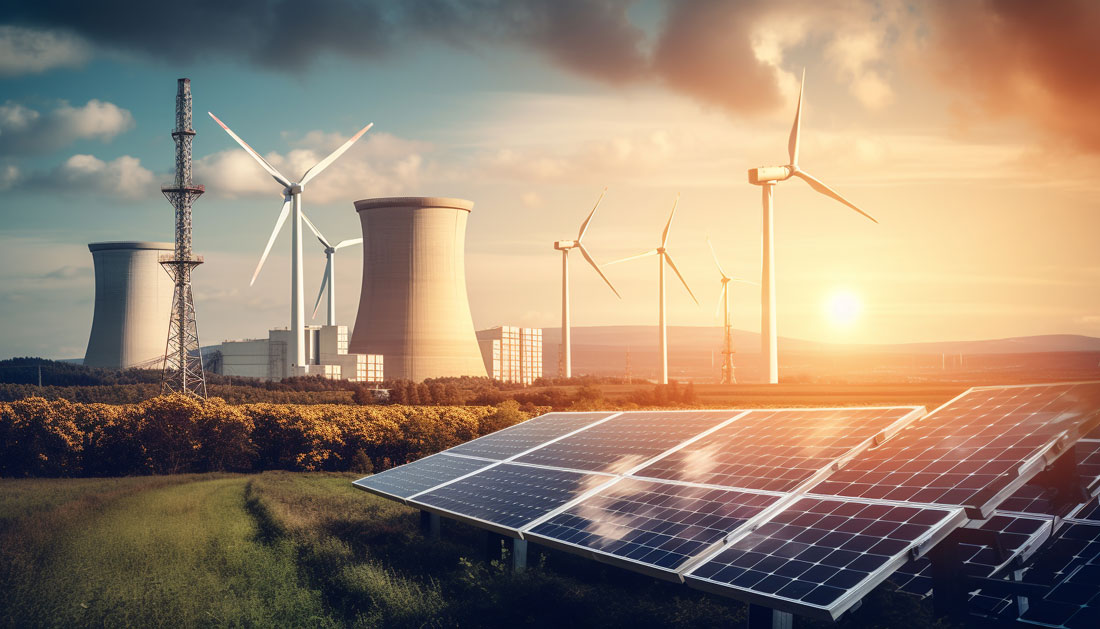The most common type of energy storage in the electricity network is pumped hydropower. But the storage technologies most frequently associated with solar power plants are electrochemical storage (batteries) with photovoltaic plants and thermal storage (fluids) with CSP plants.
Other types of storage, such as compressed air storage and flywheels, may have different characteristics, such as very fast discharge or very large capacity, that make them attractive to grid operators. More information about other storage types is provided below.
Pumped-Storage Hydropower
Pumped storage hydropower is a water-based energy storage technology. Electrical energy is used to pump water to a tank when the demand for energy is low. Later on, water can go down and turn a turbine to generate electricity when demand is high. Pumped hydro power is a proven storage technology used in the United States since 1929.
However, there is a need for suitable landscapes and reservoirs, which may be natural or man-made lakes by constructing dams, requiring lengthy regulatory permits, long implementation times, and large initial capital. Apart from energy arbitrage, the value of pumping services to integrate variable renewables is not fully realized, which can extend the period of financial recovery.
These are some of the reasons pumped hydro has not been built recently, even though interest is evident from requests to the Federal Energy Regulatory Commission for preliminary permits and licenses.
Electrochemical Storage
Many of us know about electrochemical batteries, such as those found on laptop computers and cell phones. When power is injected into a battery, it causes a chemical reaction and the energy is stored. When a battery is discharged, this chemical reaction is reversed, creating a voltage between two electrical contacts, causing the current to drain off the battery. The most common chemistry of battery cells is lithium-ion, but other common options include lead-acid, sodium, and nickel-based batteries.
Thermal Energy Storage
Thermal energy storage is a family of technologies in which a fluid, such as water or molten salt, or other material is used to store heat. That thermal storage material is then stored in an insulated tank energy is required. The power can be used directly for heating and cooling, or it can be used to produce electricity. In electric thermal energy storage systems, heat is used to boil water.
The resulting steam drives a turbine and produces electricity using the same equipment used in traditional power plants. Thermal energy storage is useful in CSP plants, which focus sunlight on a receiver to heat a working fluid. The Supercritical carbon dioxide is being explored as a working medium that could benefit from higher temperatures and reduce the size of power plants.
Flywheel Storage
A flywheel is a heavy wheel attached to a rotary tree. Spending power can turn the wheel faster. This energy can be removed by attaching the wheel to an electric generator, which uses electromagnetism to slow down the wheel and produce electricity. Although flywheels can quickly provide power, they can’t store a lot of energy.
Compressed Air Storage
Compressed air storage systems consist of large vessels, like tanks, or natural formations, like caves. A compressor system pumps the vessels full of pressurized air. Then the air can be released and used to drive a turbine that produces electricity. Existing compressed air energy storage systems often use the released air as part of a natural gas power cycle to produce electricity.
Solar Fuels
Solar power can be used to create new fuels that can be combusted (burned) or consumed to provide energy, effectively storing the solar energy in the chemical bonds. Among the possible fuels researchers are examining are hydrogen, produced by separating it from the oxygen in water, and methane, produced by combining hydrogen and carbon dioxide. Methane is the main component of natural gas, which is commonly used to produce electricity or heat homes.
Virtual Storage
Energy can also be stored by changing how we use the devices we already have. For example, by heating or cooling a building before an anticipated peak of electrical demand, the building can “store” that thermal energy so it doesn’t need to consume electricity later in the day. The building itself is acting as a thermos by storing cool or warm air. A similar process may be applied to water heaters to spread the demand throughout the day.
Ultimately, residential and commercial solar customers, as well as utilities and large-scale solar operators, can benefit from solar energy storage systems. As research continues and solar and storage costs decrease, solar and storage solutions will become more available to all Americans.
Reference: https://www.energy.gov/eere/solar/solar-integration-solar-energy-and-storage-basics


